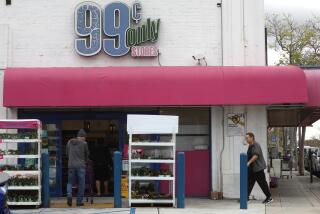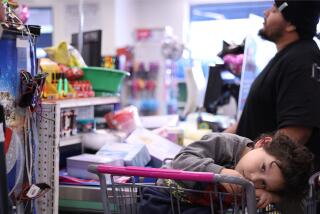Will Circuit City Invade the S.D. Market? : Consumer Electronics Chains Could Face Tough New Competition
- Share via
Christmas sales. Pre-Christmas sales. After-Christmas sales. White sales. Excess inventory sales. Truckload sales. Carload sales. Trainload sales. Factory direct sales. Factory blowout sales.
If you listen to San Diego-area consumer electronics retailers, every day is an unbelievable buying opportunity as long you buy it today, right now, this instant. And if the message already sounds strident, you may not have heard anything yet.
This year, consumers will see the first major price increases for goods such as television sets, stereo systems and video cassette recorders since color broadcasting began. The price hikes should further dampen already slack consumer demand.
At the same time, the expansion plans of national consumer electronics specialists such as Silo and Circuit City could lead to intensified competition with home-grown San Diego chains such as Dow Stereo and Mad Jack’s.
Ready for War
A retail war is about to be fought here for the hearts, minds and pocketbooks of San Diego consumer electronics buyers.
Dow and Mad Jack’s seem to own the biggest shares of San Diego’s $300-million consumer electronics market. Dow claims to be top dog with a 15% market share. Established in 1973, Dow currently has five stores and plans to open two more this year.
“Anybody can come up with numbers,” Mad Jack’s Dave Sprosty responded. “We have a friendly battle going with Dow so we will say that we have 15% of the market, too.” Mad Jack’s, founded by two San Diego State University students 15 years ago, has seven stores and no current expansion plans.
Which is larger? Consumer Electronics, a trade magazine, estimated Dow’s 1987 annual revenues at about $30 million and Mad Jack’s at about $25 million. Neither of the privately held firms would confirm or deny those figures.
But both Dow and Mad Jack’s face formidable, well-financed and growing competition. Silo, America’s third-largest consumer electronics specialist, seems determined to make a run at Dow’s market share, having just opened its seventh San Diego-area store on El Cajon Boulevard. Silo plans to open at least two more stores, perhaps more, in San Diego County.
Feeling ‘Bullish’
“We are bullish that we can get the business,” said Jay Winslow, president of Silo’s western division. “We always have gotten the business, and we always will get the business.”
Consumer Electronics estimated Silo’s annual sales nationally at $480 million. San Diego probably accounted for about $20 million of the total.
Silo is not the only retailer with its eye on growth in San Diego. Los Angeles-based Leo’s Stereo, a 40-store chain with annual revenue estimated at $120 million, recently opened a store in Carlsbad and plans to open two more in San Diego County in 1988, bringing its total to seven. Montgomery Ward opened a consumer electronics specialty shop in Oceanside last spring. Based on that store’s results, Ward will announce its expansion plans this month.
But the great unanswered question is what Circuit City will do. Circuit City is the nation’s largest consumer electronics specialist--the first to top $1 billion in yearly sales. It has announced it will open 20 to 25 stores next year but declined to say whether San Diego figures in its expansion plans.
When Circuit City moves into an area, it moves in with a vengeance, flooding newspapers and broadcast media with advertisements. In 1986, it opened eight stores in the San Francisco Bay area within two months. It currently operates 24 stores in Southern California and has at least two stores in every Southland county except San Diego.
‘Take a Slice’
If Circuit City does invade San Diego, the effect could be dramatic, said Stan White, district manager at Leo’s, which competes with the retailer in Los Angeles. “The pie will be spread thinner and they will take a slice.”
“They cleaned Federated Group’s clock in Los Angeles,” observed another retailer. Los Angeles had been considered the Federated Group’s stronghold, but its battering by Circuit City led, in part, to its sale to Atari Corp. last fall.
The Federated Group operates five stores in the San Diego area but did not return several phone calls to discuss its expansion plans, if any, for San Diego.
Regardless of what Circuit City and the Federated Group do, the number of consumer electronics stores in the county should increase by 25% to 30% in the next 12 months, industry observers say. That rapid expansion comes at time when the market as a whole is undergoing significant changes.
After years of spectacular results fueled by the popularity of the video cassette recorder and low prices for Japanese-manufactured goods due to the strong dollar in the early and mid-1980s, the growth rate in most major product categories has slowed.
According to the Electronics Industry Assn., wholesale sales rose only 3.8% in 1987 to $29.8 billion. By contrast, in 1986, wholesale sales rose more than 11%.
VCR Sales Off
The most dramatic falloff came in video cassette recorders, for years the hottest piece of consumer electronics equipment.
“There was almost no growth in units sold,” said Cynthia Saraniti, spokeswoman for the electronic association’s consumer electronics group. “And we don’t expect that there will be dramatic increases like before.” With more than a 50% household penetration rate, the VCR market, to a degree, has been saturated.
To make matters worse, retailers generally are coming off a sluggish Christmas season. Nationally, said analyst Underwood, “Christmas was spotty . . . not great but OK.”
Most area retailers agreed with that assessment, admitting that overall sales seemed to be running slightly behind last year. A spot survey of consumer electronics specialty stores in North County on the weekend before Christmas revealed that store traffic was brisk but not frenzied. Most customers seemed interested in less-expensive equipment, such as personal and portable audio systems, than big-ticket items.
“That is in line with a general flattening of consumer spending that started in the summer,” said Edwin Underwood, consumer electronics analyst with the brokerage firm Scott and Stringfellow in Richmond, Va. Last fall’s stock market crash also produced some consumer uncertainty, he added.
Dollar Drop
The final blow for consumer electronics retailers has been the drop in the value of the dollar against the yen, which is forcing prices up.
“We expect across-the-board price increases of 15% to 20% in every product category, even blank tape,” said Dow’s Romagnolo. If the price increases stick, it will be a first in consumer electronics retailing.
Though nobody expects that a 10% price rise will immediately extinguish demand, nobody believes that it won’t have any effect either.
“It all depends on how price-sensitive the consumer is,” said Leone Johnson, a consultant for Venture Development Corp., a market research firm based in Natick, Mass. “I don’t know if a 10% hike will make somebody turn around and walk out the door.”
Whether it will or it won’t, the combination of slow growth, rising prices and a soft retail market generally has changed the climate in which consumer electronics retailers are operating. “In the past,” said Murray Slovick, editor of Dealerscope, a trade publication, “retailers have been willing to sacrifice their margins to gain market share. Now they have to recognize that the bottom line is of greatest importance. You will see less irresponsible product blowouts.”
Establishing a Niche
Though price will remain important, according to Slovick, retailers may be forced to compete more on service, support and sales presentation to establish their own niche.
Those are grounds on which local retailers say they are ready to do battle. But if there is a meaningful difference in the way retailers generally sell consumer electronics, the message may not be getting through to consumers.
“I always check the prices at Circuit City in Los Angeles and then shop at Leo’s or Mad Jack’s,” said Neil Goren, a field engineer with International Equipment, manufacturer of laboratory equipment, who was shopping for a cassette deck on the weekend before Christmas. “You match features, power and prices and then go for the best deal.”
When retailers believe they are catering to a price-oriented customer base, the volume level of their advertising usually goes up. “San Diego is a very reactive market,” said Gary Beyler, manager of the mobile electronics division at Mad Jack’s. “There was a time when we thought we were too aggressive in our advertising and tried to tone it down. But the customers stopped coming.”
In the past, law enforcement officials have felt that the advertising hard sell was turned up too high. “Everybody has been talked to by the district attorney,” said Mad Jack’s Sprosty.
Competition has taken its toll. In the past two years, Pacific Stereo in Emeryville, Calif.; CMC in St. Louis, Mace Electronics in Pennsylvania, and several other regional chains have been forced into bankruptcy. The Federated Group and Crazy Eddie’s of New York were sold after they lost millions of dollars.
Local retailers seem unintimidated by outside interlopers, however.
“Los Angeles was a plum waiting to be taken,” Sprosty said. “But if they come here, we will make Circuit City’s life as difficult as possible.”
And the national chains have a word for local retailers. Said Silo’s Jay Winslow: “Nobody can own a market forever.”
More to Read
Inside the business of entertainment
The Wide Shot brings you news, analysis and insights on everything from streaming wars to production — and what it all means for the future.
You may occasionally receive promotional content from the Los Angeles Times.










